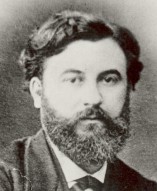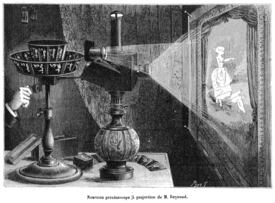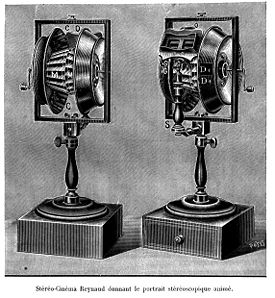fiction.wikisort.org - Director
Charles-Émile Reynaud (8 December 1844 – 9 January 1918) was a French inventor, responsible for the praxinoscope (an animation device patented in 1877 that improved on the zoetrope) and was responsible for the first projected animated films. His Pantomimes Lumineuses premiered on 28 October 1892 in Paris. His Théâtre Optique film system, patented in 1888, is also notable as the first known instance of film perforations being used. The performances predated Auguste and Louis Lumière's first paid public screening of the cinematographe on 26 December 1895, often seen as the birth of cinema.

This article needs additional citations for verification. (May 2017) |
Émile Reynaud | |
|---|---|
 | |
| Born | 8 December 1844 Montreuil, Seine-Saint-Denis, France |
| Died | 9 January 1918 (aged 73) Ivry-sur-Seine, Seine (now Val-de-Marne), France |
| Occupation | Science teacher, inventor |
Biography
Charles-Émile Reynaud was born on 8 December 1844 in Montreuil-sous-Bois (now a suburb of Paris). His father Benoît-Claude-Brutus Reynaud was an engineer and medal engraver originally from Le Puy-en-Velay and his mother Marie-Caroline Bellanger had been a school teacher, but stayed at home to raise and educate Émile from his birth. Marie-Caroline was trained in watercolor painting by Pierre-Joseph Redouté and taught her son drawing and painting techniques. Brutus gave him little tasks in his workshop and by the age of 13 Émile was able to build small steam engines. In 1858 he became an apprentice at a Paris company where he repaired, assembled and developed optical and physics instruments. He then learned industrial design at another company, before working as an operator for photographer Antoine Samuel Adam-Salomon. By 1862 he started his own career as a photographer in Paris. He became an assistant to the famous Abbé Moigno in 1864. Moigno gave lecture-screenings with the magic lantern and converted Émile to Catholicism, since his parents had raised him without religion. When his father died in December 1865 Émile moved with his mother to Puy-en-Velay where Brutus' cousin Dr. Claude Auguste Reynaud further educated Émile in Greek, Latin, physics, chemistry, mechanics and natural science. In December 1873 Émile Reynaud started giving weekly scientific screening-lectures for the students of the industrial schools of Puy-en-Velay, free of charge and open to the general public. He used personally made photographic magic lantern slides in two projectors, sometimes dissolving from one projection to another.[1][2]
After Reynaud read a series of articles on optical toys published in La Nature in 1876, he created a prototype praxinoscope out of a discarded cookie box.[2] He applied for a French patent on 30 August 1877 for his then unnamed device (settling on the name Praxinoscope before the English patent of 13 November 1877) and returned to Paris in December 1877 to manufacture and market his invention.[2][3]
On 21 October 1879 Émile Reynaud married Marguerite Rémiatte in Paris. They had two sons: Paul (1880) and André (1882).
Similarly to Georges Méliès, Reynaud's late years were tragic after 1910 when, his creations outmoded by the cinematograph, dejected and penniless, he threw the greater part of his irreplaceable work and unique equipment into the Seine. The public had forgotten his "Théâtre Optique" shows, which had been a celebrated attraction at the Musée Grevin between 1892 and 1900. He died in a hospice on the banks of the Seine where he had been cared for since 29 March 1917.


Filmography
The 5 Pantomimes Lumineuses were painted directly onto a transparent strip of images of shellac protected gelatin and manipulated by hand to create an approximately 15 minute show comprising approximately 500 images per title. The three Photo-peintures animées (animated photo-paintings) were directed with the Photo-Scénographe, a camera inspired by the Chronophotographe à bande mobile of Étienne-Jules Marey.
| Release year | Date | Film | Images | Length | Duration | Actors | Status |
|---|---|---|---|---|---|---|---|
| 28 October 1892 | 1888 | Un bon bock | 700 | 50 m | 15 mn | few images preserved | |
| 1890 | Clown et ses chiens | 300 | 22 m | c. 10 mn | lost | ||
| 1891 | Pauvre Pierrot | 500 | 36 m | c. 15 mn | all preserved | ||
| December 1894 | 1893 | Autour d'une cabine | 636 | 45 m | c. 15 mn | preserved | |
| 1893 | Un Rêve au coin du feu | 400 | 29 m | c. 12 mn | lost | ||
| Photo-peintures animées | |||||||
| 1896 | 1896 | Guillaume Tell | Clowns Footit and Chocolat | few images preserved | |||
| 1897 | 1896 | Le Premier cigare | Félix Galipaux | ||||
| Not released | 1898 | Les Clowns Price | Clowns Price of the Alhambra |
- The two preserved short animated films
- Video of Pauvre Pierrot, the first preserved animated cartoon, 1891
- Autour D'une Cabine, from 1894, one of the first animated films
 Autour d'une cabine
Autour d'une cabine
Praxinoscope strips (1877–1879)
- La Rosace Magique
- Le Trapèze
- Le singe musicien
- Le fumeur
Series 1
- L'Aquarium
- Le Jongleur
- L'Équilibriste
- Le Repas des Poulets
- Les Bulles de Savon
- Le Rotisseur
- La Danse sur la Corde
- Les Chiens Savants
- Le Jeu de Corde
- Zim, Boum, Boum
Series 2
- Les Scieurs de Long
- Le Jeu du Volant
- Le Moulin à Eau
- Le Déjeuner de Bébé
- La Rosace Magique
- Les Papillons
- Le Trapèze
- La Nageuse
- Le Singe Musicien
- La Glissade
Series 3
- La Charmeuse
- La Balançoire
- L'Hercule
- Les Deux Espiègles
- Le Fumeur
- Le Jeu de grâces
- L'Amazone
- Le Steeple-chase
- Les Petits valseurs
- Les Clowns
Inventions

- The praxinoscope, 1876
- The praxinoscope-jouet (toy praxinoscope), 1877
- The praxinoscope-théâtre, 1879
- The projecting praxinoscope, 1880
- Image bands with central perforation.
- The Théâtre Optique, 1888
- The stéréo-cinéma (animations in 3D), 1907
Books and references
- Dominique Auzel, Émile Reynaud et l'image s'anima biographie d'Émile Reynaud
- éditions du May (1992), ISBN 2-906450-72-3 (photos en couleurs)
- And at Dreamland éditeur (2000), ISBN 2-910027-37-6 (photos en noir et blanc)
References
- "Biographie".
- Myrent, Glenn (1989). "Emile Reynaud: First Motion Picture Cartoonist". Film History. 3 (3): 191–202. JSTOR 3814977.
- Laurent Mannoni Light and Movement, 1995, pp. 232–233
External links
- Charles-Émile Reynaud at IMDb
- Kinodinamico
- Who's Who of Victorian Cinema Biography
- Biography
- Biography
- Interactive display about Reynaud from the Cinémathèque française
На других языках
- [en] Émile Reynaud
[ru] Рейно, Эмиль
Эмиль Рейно (фр. Charles-Émile Reynaud /ʃaʁl emil ʁɛjno/; 8 декабря 1844, Монтрёй — 9 января 1918, Иври-сюр-Сен) — французский изобретатель, художник и популяризатор науки, предтеча мультипликации.Другой контент может иметь иную лицензию. Перед использованием материалов сайта WikiSort.org внимательно изучите правила лицензирования конкретных элементов наполнения сайта.
WikiSort.org - проект по пересортировке и дополнению контента Википедии
